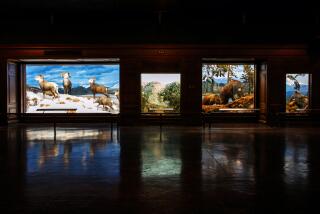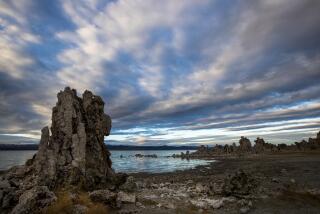Telling It Lake It Is--and Was : Photography: The group exhibit in Fullerton celebrates Mono’s beauty but also conveys the destruction that has been caused by water diversion.
- Share via
FULLERTON — Photographer Stephen Johnson fell in love at first sight. A startling and alluring beauty, Mono Lake quickly drew him in and demanded his repeated return, camera in hand.
“It’s improbable. It’s this huge, blue body of water amid this vast, dull desert,” Johnson said recently.
Formed long before humans walked the earth and encircled by strange, lunar-like structures that look like stalagmites, the lake at the eastern base of the soaring Sierra evokes a sense of eternity, a spiritual response, Johnson said. “It’s a source of inspiration and solace to anybody who spends time there.”
But soon after his initial visit in the late ‘70s, Johnson witnessed a “tragedy” unfolding. The city of Los Angeles was still diverting water from the lake’s tributary streams, which over the years had lowered the lake’s level more than 40 feet and devastated its wildlife. Hoping to help, Johnson organized a photographic group show that has toured the country and opens today at the Fullerton Museum Center.
With aerial photos of white salt flats along shores where blue water once flowed and close-ups of dead birds, “At Mono Lake” conveys the destruction caused by water diversion that began in 1941.
But most of the exhibit’s 110 prints celebrate the lake’s transcendent beauty. Works by about dozen photographers, including Johnson, such renowned figures as Ansel Adams and Edward Weston, and lesser-known artists, feature fiery sunsets, wind-swept clouds and snow-covered peaks mirrored in placid waters, and bizarre, knobby tufa towers--the stalagmite-like spires--in haunting tableaux that recall science-fiction film sets.
Last April, an Eldorado County Superior Court judge barred further water diversion by the Los Angeles Department of Water and Power until the lake level rises another 2 feet to ensure protection of millions of migratory and nesting birds and other wildlife. The struggle to balance Los Angeles’ water needs with environmental concerns is far from over, but the ruling capped a legal battle between the city and the Mono Lake Committee, an environmental group with 20,000 members worldwide, which Johnson approached as he began organizing the show. He didn’t want to get involved in a political crusade, however.
“It was purposefully a nonpolitical exhibit from the beginning, never an effort to say ‘Save Mono Lake,’ ” he said. “There wasn’t really a need for that. I think the beauty of Mono speaks for itself. Our intention was to document the wonder of the place and invoke the same feelings in viewers that inspired photographers to work there.”
Mono Lake was developed through volcanic eruptions and fault activity that began about 3 million years ago. It is depicted at the museum center in black-and-white and color prints from 1868 to 1983, the year before the show’s four-year national tour concluded, Johnson said. The exhibit has since been kept in storage, except when requested by institutions that missed it the first time around.
The show seemed timely in light of the state’s protracted drought, said Lynn La Bate, Fullerton Museum Center curator.
“Especially now, anything that will bring attention to water conservation and California’s natural resources is worthy,” said La Bate, adding that related educational events will be held during the show’s one-month run.
Johnson, who lives in Pacifica, south of San Francisco, specializes in nature photography and has curated other environmental shows. He said that Brett Weston, Edward’s son, provided the final impetus for the Mono Lake project.
During a 1979 visit, Johnson said, “I told (Brett) I had this idea to do the show, and he said, ‘I am the original Mono maniac!’ He’d been out there photographing since the early ‘50s, so he had not only a body of beautiful work, but he was very enthusiastic about the show.”
Johnson said Ansel Adams responded similarly, readily agreeing to lend his work. “That really made it clear it was possible to put together a show of this breadth and importance. Once a couple people of such fame sign on, it makes everything much easier.”
Johnson had help from fellow Bay Area photographers Al Weber and Don Worth in gathering other works. Worth was Johnson’s teacher at San Francisco State, where he earned a graduate degree in fine arts. The three went after historic works (including Civil War photographer Timothy O’Sullivan’s 1868 wet-plate albumen prints), as well as contemporary images.
“There are a lot of young photographers in the show,” most of them from California, Johnson said. “I wanted to stimulate new photography as well as discover old documentation.”
The newer works include Landsat satellite images as well as shots through a high-resolution microscope of small life forms.
Now, more than a decade since its inception, the exhibit will finally “go home” after its Fullerton run, Johnson said. A new visitors center at Mono Lake will be host to the show in March or early April, he said. Johnson hopes the facility will put the collection on permanent display.
“To stand in the gallery and see the photographs of Mono, then turn around and see it for real--that’s a feeling I’m looking forward to.”
“At Mono Lake,” a 110-piece photographic group exhibit, runs today through Feb. 23 at the Fullerton Museum Center, 301 N. Pomona Ave., Fullerton. A kinetic installation by Mineko Grimmer is also on view. Related educational events include: “The Wilderness Journal,” an environmental documentary that will be shown continuously; a Feb. 15 discussion of issues raised in the environmental film “The Wilderness Idea,” and a Feb. 22 children’s science workshop about lake ecosystems. Center hours are 11 a.m. to 4 p.m., Tuesday, Wednesday, Saturday and Sunday; 11 a.m. to 9 p.m., Thursday and Friday. Admission: $2 for adults, $1 for students and seniors. Information: (714) 738-6545.
More to Read
Sign up for Essential California
The most important California stories and recommendations in your inbox every morning.
You may occasionally receive promotional content from the Los Angeles Times.













